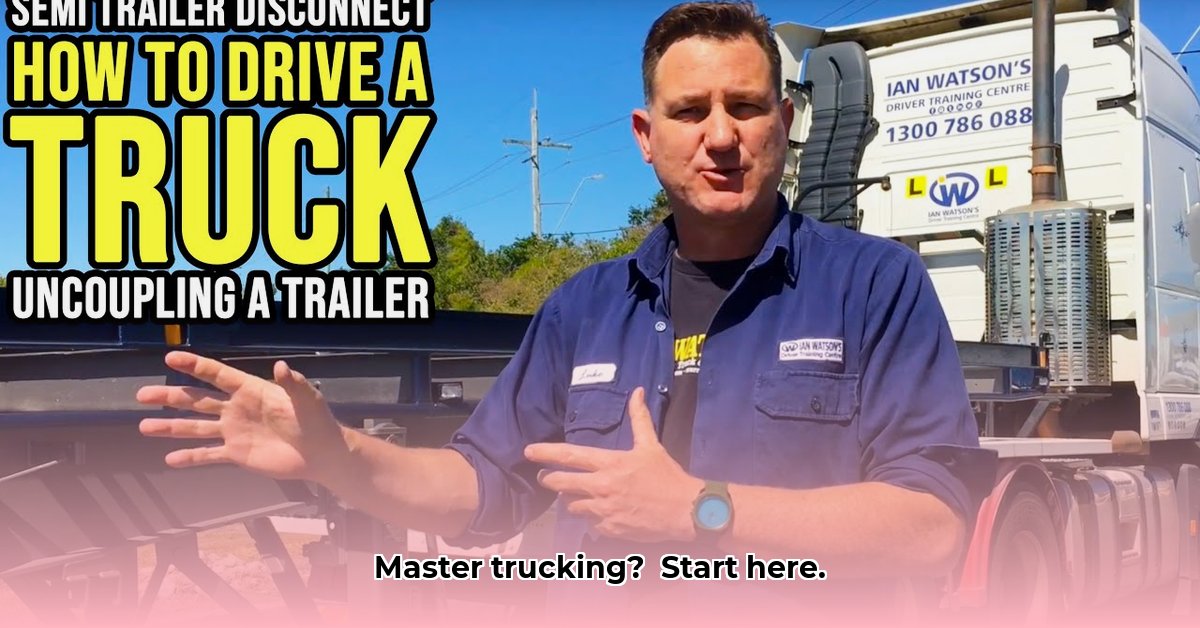
Getting Your Commercial Driver's License (CDL)
Before you even consider driving a semi-truck, you must obtain a Commercial Driver's License (CDL). This specialized license requires passing rigorous knowledge, skills, and safety tests. Think of it as a professional certification for operating large commercial vehicles. Enrollment in a reputable CDL training program is strongly advised. These programs provide structured learning, hands-on practice, and crucial safety training. What is the most efficient way to obtain your CDL? Learn more about backing techniques by visiting this helpful guide: Backing a Tractor Trailer.
Pre-Trip Inspection: Your Safety Checklist
A thorough pre-trip inspection is non-negotiable; it's the cornerstone of safe operation. This isn't a cursory glance; it's a detailed examination of every truck system. A pre-trip inspection is much more than just a glance—it's a detailed, systematic check of your vehicle's critical systems. Failing to conduct a thorough pre-trip inspection can lead to serious safety issues down the road.
Step-by-Step Pre-Trip Inspection:
Exterior Examination: Begin by circling the truck, carefully checking tires for wear and damage, examining lights and reflectors for functionality, inspecting mirrors for proper adjustment and clarity, and looking for any signs of leaks, damage to the undercarriage, or anything unusual.
Engine Compartment Inspection: Open the hood and thoroughly inspect the engine compartment. Check fluid levels (oil, coolant, brake fluid, power steering fluid, etc.), examine belts and hoses for wear or damage, and look for any leaks or unusual conditions.
Interior Assessment: Examine the cabin interior. Ensure seatbelts are functioning correctly, gauges and warning lights are operating as expected, and all controls are responding properly.
Documentation: Meticulously record any issues discovered, no matter how minor, in your driver's logbook. This detailed record-keeping is critical for maintenance and safety.
Basic Semi-Truck Operation: Starting and Driving
Driving a semi-truck significantly differs from operating a car. The sheer size, weight, and unique controls require a different approach. Mastering the clutch, accelerator, and gear shifting takes practice and patience.
Starting the Engine: Engage the parking brake, place the transmission in neutral, turn the ignition key, and slowly release the parking brake.
Steering: Semi-trucks possess a substantially longer wheelbase than cars, demanding wider turns and heightened maneuverability, especially in tight corners.
Braking: Due to the immense weight, anticipate stops considerably earlier than you would in a passenger vehicle. Effective braking often involves a combination of engine braking and service brakes.
Gear Shifting: Smooth shifting is vital. Jerky movements can harm the transmission and create an uncomfortable ride. Mastering this skill improves efficiency and safety.
What are the most common mistakes new semi-truck drivers make when shifting gears?
Advanced Maneuvers: Backing, Docking, and Coupling
Backing up a semi-trailer is notoriously challenging, even for experienced drivers. Adequate space, a spotter (someone to guide you visually), and patience are essential.
Backing Up: Practice in a safe, open area. Use the GOAL method—Get Out And Look—before each maneuver. Small, precise steering adjustments are key.
Docking: Approach loading docks methodically, using mirrors and/or backup cameras. Small steering and shifting adjustments will help you position the trailer more effectively.
Coupling/Uncoupling: Follow established procedures carefully. Ensure that the coupling is secure before moving. Proper coupling/uncoupling will ensure the safety of both equipment and personnel.
Load Management: Weight Distribution and Securement
Understanding and adhering to weight distribution regulations is crucial for safety. Overloading a truck is illegal and dangerous. Secure your cargo properly to prevent shifting during transit. A loaded truck is very different to drive than an empty one; here is a chance to learn the differences.
Safety Regulations: Hours of Service (HOS) and DOT Compliance
The trucking industry has strict safety regulations, including Hours-of-Service (HOS) rules to prevent driver fatigue. Always comply with Department of Transportation (DOT) regulations and maintain a clean driving record. What are the potential consequences of violating HOS rules?
Troubleshooting Common Issues
While not expected to be a mechanic, familiarity with basic troubleshooting can prevent small problems from escalating. For example, knowing how to check tire pressure, how to check your fluids, and recognizing signs of overheating is vital for preventing further damage.
Ongoing Training and Professional Development
Continuous learning is crucial for maintaining proficiency and safety in the trucking industry. Stay updated on industry best practices and seek advanced training opportunities to enhance your skills and remain compliant with safety regulations. What additional certifications or training programs could benefit your career as a truck driver?
Three Pivotal Points:
- Safety First: A pre-trip inspection and adherence to safety regulations are paramount.
- Mastering the Basics: Proficiency in basic truck operation is foundational to safe and efficient driving.
- Continuous Learning: Ongoing training and professional development are essential for career advancement and safety.